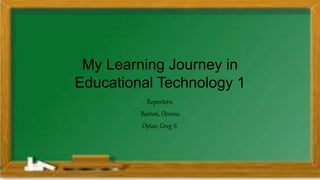
My Learning Journey in Educational Technology
- 1. My Learning Journey in Educational Technology 1 Reporters: Barton, Dennis Opiso, Greg S.
- 2. When students learn with technology 1 2 4 5 73 6
- 3. It is the knowing, making, modifying, and using the tools, machines, techniques, crafts, systems, and method of organization, in order to solve a problem, improve a pre-existing solution to a problem, achieve a goal, handle an applied input/output relation or perform a specific function. Technology as the use of gadgets, tools, or equipment to perform a task expediently and efficiently.
- 4. This refers to reliable devices that enable one to make presentations repeatedly. Technology as the collection of tools including machinery, modifications, arrangements and procedures.
- 5. Some people need to use gadgets or tools to perform home chores faster like washing machine, rice cooker, hair blower, electric fan, floor polisher, electric foo mixers, blenders, and grinders. Other technology-related appliances are radio, television, music player, and digital camera. These equipment entertain people through listening watching, or documenting events. Other gadgets as technology.
- 6. After describing some gadgets associated with technology, one very important technology asset is the teacher. Teacher as technology.
- 7. 1. Technology is more than hardware. This will happen when students learn with technology. To realize this, the following assumptions about technology are agreed upon.
- 8. This will happen when students learn with technology. To realize this, the following assumptions about technology are agreed upon. 2. An environment or definable set of activities that engage learners in active, constructive intentional, and authentic learning.
- 9. This will happen when students learn with technology. To realize this, the following assumptions about technology are agreed upon. 3. Observe as resource materials for reflection and other thinking skills.
- 10. 4. Technologies support learning when: This will happen when students learn with technology. To realize this, the following assumptions about technology are agreed upon. A B
- 11. This will happen when students learn with technology. To realize this, the following assumptions about technology are agreed upon. 5. Interactions with the technologies are conceptually and intellectually engaging.
- 12. This will happen when students learn with technology. To realize this, the following assumptions about technology are agreed upon. 6. Should function as intellectual tools kits that enable the learners to build more meaningful personal interpretations and representations of the world.
- 13. This will happen when students learn with technology. To realize this, the following assumptions about technology are agreed upon. 7. Learners and technologies should be intellectual partners in the learning process where cognitive responsibility when performing is distributed to the part of the partnership that perform is the best.
- 14. Example: Students can download sample rubrics to enable them to create their own rubric A.They fulfill a learning need.
- 15. The students develop power point presentation to make a clear interesting report within a given time limit. When slides are presented, the classmates can easily understand the ideas being presented. B. Interactions with technologies are learner-initiated and learner controlled.
- 16. • The teacher and the learner should be able to select technologies which can help learners attain the intended outcomes of instruction. Educational technology as the selection, development, managing and use of appropriate technological process and resources.
- 17. • As application of theory and practice, Educational Technology has five domains namely, design, development, utilization, management and evaluation of processes and resources for learning (Association for Educational Communication and Technology or AECT). Educational technology as the choice of appropriate principles in the preparation and utilization of conventional and non- conventional technology tools as well as traditional and alternative teaching strategies.
- 18. Development Design Evaluation Management Utilization Theory and Practice Development Utilization Evaluation Theory and Practice Development UtilizationManagement Evaluation Theory and Practice Development Utilization
- 19. THEORY AND PRACTICE • Instructional System Design • Instructional Strategies • Learner’s characteristics Establish a framework to guide in planning the educational technology. Domain 1 - Design
- 20. THEORY AND PRACTICE DEVELOPMENT • Print technologies • Audio technologies • Still visuals • Audio-visual technologies • ICTs • Electronic technologies • Integrated technologies Using the design or framework, materials are produced and developed. Domain 2 - Development
- 21. THEORY AND PRACTICE UTILIZATION • Media • Utilization • Implementation • Institutionalization • Policies and regulation Implementing and using the learning materials used to enhance knowledge and skills of learners. It is also know as the action phase. Domain 3 - Utilization
- 22. THEORY AND PRACTICE MANAGEMENT • Project Management • Resources Management • Management of Delivery System • iffusion of Innovation It is applied in the implementation of all the different domains and its effect on the outcomes of learning. Domain 4 - Management
- 23. THEORY AND PRACTICE EVALUATION • Problem analysis • Measurement • Formative Evaluation • Summative Evaluation Monitoring, assessing, and giving judgment on the extent of usefulness of the learning material in achieving the expected outcomes. Domain 5 - Evaluation